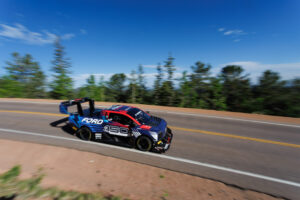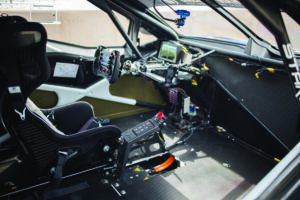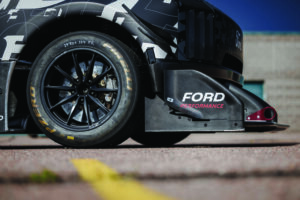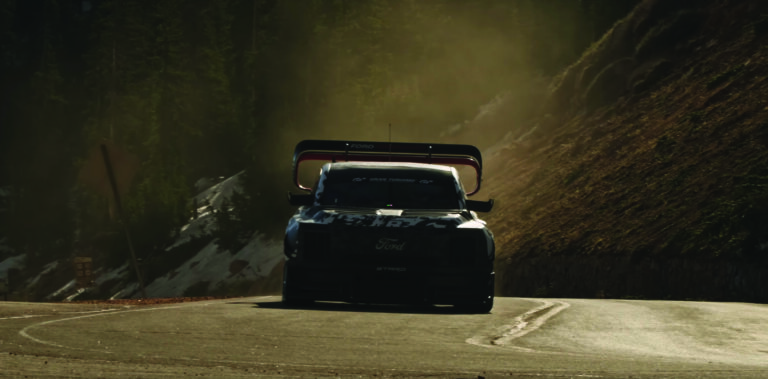In 2024, Ford had a score to settle at Pikes Peak. The OEM took the open class record up the 19.9km road to the mountain’s summit with its SuperVan 4.2 EV in 2023, but missed out on the overall win. It was a matter of pride that having got so close, the Blue Oval had to return and go for the win. Its weapon of choice? SuperTruck.
The powertrain of the SuperTruck is closely related to its predecessor, consisting of a modular motor package developed by Austrian supplier Stard, a company that Ford has worked with on a variety of EV projects, including the Mustang Cobra Jet 1800 drag car and the Mustang Mach-E 1400. The package allows for the use of three or four motors, with the three-motor combination run at Pikes Peak in both 2023 and 2024 – two at the rear and one at the front. However, competition is fierce at the Race to the Clouds, and Ford had to up its game to be in with a shot at the win.
“We knew we had to improve with the SuperTruck,” says Sriram Pakkam, Formula 1 and electrified demonstrator senior manager at Ford Performance. “Given that that was a van and this is a truck, neither is an ideal platform for a race car, right? They’re both huge, so you still face some of the same problems.” The chassis was always going to be substantial, though Pakkam points out that at least the truck has a lower roofline, a slight reduction in frontal area and a shorter length. “But they are still both very large. The physics is the physics and you’re not getting around some of those flaws.”
 However, what Ford’s engineers could do is compensate in other areas. According to Pakkam, more than 80,000 simulations were run to understand the performance sensitivity to power, aero and weight. From this it was found that weight reduction would always bring a consistent, linear benefit to lap time. However, with downforce and power there was a definite plateau once a certain level was reached.
However, what Ford’s engineers could do is compensate in other areas. According to Pakkam, more than 80,000 simulations were run to understand the performance sensitivity to power, aero and weight. From this it was found that weight reduction would always bring a consistent, linear benefit to lap time. However, with downforce and power there was a definite plateau once a certain level was reached.
Powertrain gains
Vital to keeping mass under control was development of the powertrain. The previous three motor packages produced around 1,400bhp, upped to 1,600bhp for 2024 (the quad motor made 2,000bhp). “We knew there was a reduced benefit to going above that,” says Pakkam. “The debate was, how do we get there? We figured out ways to get it out of the existing three motors without adding a fourth, which would have meant more weight, a balance change, etc. With weight being our most sensitive parameter, we stuck with the proven setup and improved it where it was needed.”
There are still developments in the pipeline for the motor package post- Pikes Peak, specifically plans to create all-in-one electric drive units rather than the current setup with separate inverters. This will free up more packaging space but, says Pakkam, “It wasn’t race ready in our minds to go right away.”
Much of the power boost stemmed from a greater understanding of the powertrain, gathered with SuperVan – particularly on the battery side. “There is a huge amount of understanding on temperatures and what sorts of voltages you should end up being at,” says Pakkam. “Always asking, are you getting the most out of every cell possible? “There are many hundreds of cells and you’re monitoring individual cell voltages. And you obviously need very good preparation beforehand in order to be exactly where you need to be thermally.”
With the lack of warmup sessions at Pikes Peak, all this experience with the battery helped improve the cell preconditioning processes. Compared with 2023, “We were much more ready,” asserts Pakkam. Aero monster The headline aero figures for SuperTruck show a 35-40% increase in downforce compared with SuperVan 4.2. SuperVan was no shrinking violet with its aero package – but Super truck turned things up to 11. Key to the brutish aero performance – over 1,600kg of downforce at the 4,303m summit of Pikes Peak – is the underfloor.
“We’ve learned from SuperVan, and so we’ve worked at the architecture stage itself to reposition and repackage the motors, transmissions and inverters so that we could design a frame that could accommodate a very large diffuser,” says Pakkam. “This meant we had to have a very strong front end with something that can feed like a pump. So we’ve got this really big three-element wing to support all that and a giant rear wing. It’s escalated quite a bit.
 “If we zoomed out to see why we ended up with this huge amount of downforce at sea level, it’s because we wanted to ensure we had more downforce than the weight of the truck at the summit,” he explains.
“If we zoomed out to see why we ended up with this huge amount of downforce at sea level, it’s because we wanted to ensure we had more downforce than the weight of the truck at the summit,” he explains.
This was to account not only for the reduced air density but also for the fact that the surface of the track deteriorates at higher altitudes – it was only paved to the summit in 2012 – and it is there that driver Romain Dumas would benefit most from the aero grip. The aero concept is not all about brute force. Balancing the car was vital to ensure Dumas had confidence throughout a run. For example, small winglets on the A-pillars can be added or removed to fine-tune the front-to-rear load distribution.
“We use that purely for Romain’s steering feel,” says Pakkam. “There are also dive planes at the front, the headlight ducts as well, which typically control wheel wakes but also adjust front balance shift. Closing those off versus letting it flow changes the field quite a bit. You get a couple percent of balance shift and for top-line drivers that’s quite a lot.”
Simulation certainty
As with the SuperVan, Ford’s latest Pikes Peak challenger was developed almost entirely in the virtual domain rather than the wind tunnel. As Pakkam outlines, Ford Performance has great confidence in its simulation program.
“We’ve had so many different production and motorsports programs that have gone through the full loop: scale model, full-scale wind tunnel and then racetrack. And that has honed the CFD process. You don’t just arrive with a good CFD package. If people just promise pure CFD, you must ask, is it backed up by a ton of data gathering and has it been through the rigor of multiple development cycles that have fixed the CFD front end? That is also what allows us to use the driving simulator and models with confidence.”
 Of course, it is still important to keep a close eye on the correlation between track and sim. “If you find areas where you’re extrapolating and there are differences from what the driver feels on the track, we try to capture that and model it. It’s a process of constant improvement.” The short timeframe for the Pikes Peak project was a key driver for this CFD-only approach but has proved once again that Ford’s faith in its virtual capabilities is justified.
Of course, it is still important to keep a close eye on the correlation between track and sim. “If you find areas where you’re extrapolating and there are differences from what the driver feels on the track, we try to capture that and model it. It’s a process of constant improvement.” The short timeframe for the Pikes Peak project was a key driver for this CFD-only approach but has proved once again that Ford’s faith in its virtual capabilities is justified.
“We haven’t felt that it’s been deficient in any way for us,” states Pakkam. “It’s been pretty confidence-inspiring because when we first did the shakedown and put it on track and Romain got on it back in May, that was for me when I was most nervous. Was it going to have some sort of evil handling trait that we were never going to be able to shake out? Would we have to do goofy things to the suspension to compensate for the aero? We had none of that. It was, right off the bat, a very stable aerodynamic platform for which we have finely tuned the right balance window, just moving small pieces around, giving Romain the feel he needs.”
The modeling didn’t stop when the team reached Pikes Peak, with offline models being run and modified throughout the event. “We have our driving simulator engineers, and they run these offline simulations. They would capture Romain’s line and then use that as computer Romain. So, he might run the upper section of the course and we would try two or three changes, and his feedback would highlight areas where the feel wasn’t right or the car was moving around too much. We could immediately run simulations to get recommendations for further changes. Over the days at Pikes Peak, we zeroed in on this ideal setup window.”
 Ford won at Pikes Peak in 2024 and is not unique in harnessing the potential such events to push its R&D efforts, but currently it is far and away the most extreme. Why go to these lengths? Nothing else in racing presents the same possibilities for exploring the unexplored. Pikes Peak is one of the few unfettered playgrounds left for engineers. As Pakkam notes, “Whatever you learn gets carried forward and the knowledge is passed around. You can find the limits of different concepts. It’s free-form technical exploration!”
Ford won at Pikes Peak in 2024 and is not unique in harnessing the potential such events to push its R&D efforts, but currently it is far and away the most extreme. Why go to these lengths? Nothing else in racing presents the same possibilities for exploring the unexplored. Pikes Peak is one of the few unfettered playgrounds left for engineers. As Pakkam notes, “Whatever you learn gets carried forward and the knowledge is passed around. You can find the limits of different concepts. It’s free-form technical exploration!”



